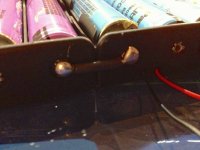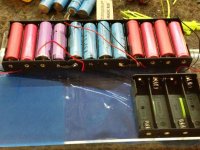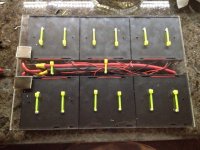Supersleeper
100 mW
- Joined
- Mar 20, 2013
- Messages
- 48
Concept:
Build a battery that is easy to maintain and replace over time and involves minimal soldering. Go as green and cost-effective as possible.
Source:
Recycled laptop batteries.
Technical Details:
12 x 18650 batteries in series per bank at 4.2v per cell will come to 50.4v total.
4 banks in parallel will estimate roughly 2 amps per bank totaling in 8 amps (conservatively)
Materials:
Clear acrylic scrap from Tap Plastics - $1
Scrap romex and recycled car wiring - FREE
6 x 18650 Case Holder on slow boat from China - $1.45 each
http://www.buyincoins.com/new_en/de...650-black-with-6-wire-leads-product-9164.html
The Layout:
View attachment 6
Soldering in Series:
 View attachment 4
View attachment 4

1/2 Complete and not yet fully charged:

Underside to contain future banks. Note the nickel plated contacts for slide-in/slide-out function:

Testing:
My tests were not performed on a full charge, nor is this a full 4 bank battery. I've only run it on 2 banks, but my 48v 1000w hub motor still was able to pull me from a dead stop and accelerate to about 20+ MPH. I look forward to a full charge and will use my GPS to calculate speed and distance for only 2 banks. I'm currently still looking for more ewaste stashes of laptop batteries, so I don't have a reason to complete the other 2 banks just yet, but more testing to come.
Build a battery that is easy to maintain and replace over time and involves minimal soldering. Go as green and cost-effective as possible.
Source:
Recycled laptop batteries.
Technical Details:
12 x 18650 batteries in series per bank at 4.2v per cell will come to 50.4v total.
4 banks in parallel will estimate roughly 2 amps per bank totaling in 8 amps (conservatively)
Materials:
Clear acrylic scrap from Tap Plastics - $1
Scrap romex and recycled car wiring - FREE
6 x 18650 Case Holder on slow boat from China - $1.45 each
http://www.buyincoins.com/new_en/de...650-black-with-6-wire-leads-product-9164.html
The Layout:
View attachment 6
Soldering in Series:
 View attachment 4
View attachment 4

1/2 Complete and not yet fully charged:

Underside to contain future banks. Note the nickel plated contacts for slide-in/slide-out function:

Testing:
My tests were not performed on a full charge, nor is this a full 4 bank battery. I've only run it on 2 banks, but my 48v 1000w hub motor still was able to pull me from a dead stop and accelerate to about 20+ MPH. I look forward to a full charge and will use my GPS to calculate speed and distance for only 2 banks. I'm currently still looking for more ewaste stashes of laptop batteries, so I don't have a reason to complete the other 2 banks just yet, but more testing to come.


